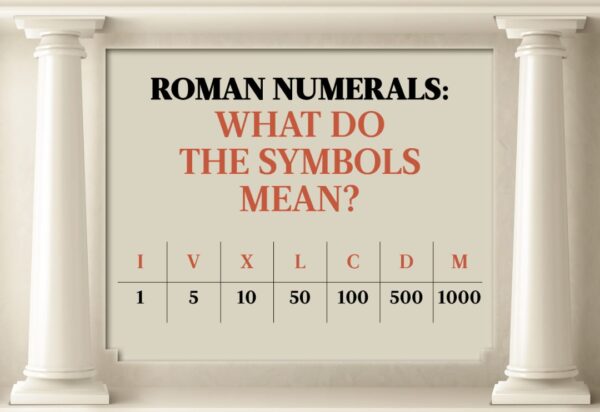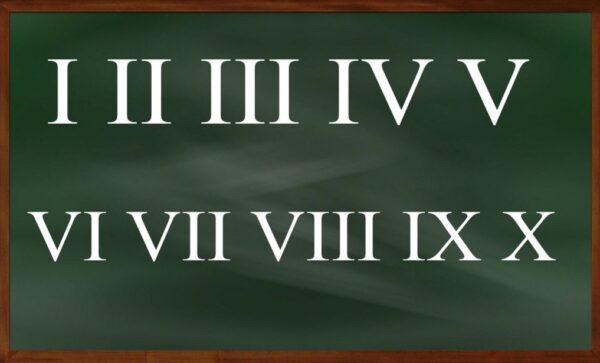Roman numbers are a part of a numeral system that was used in ancient Rome to represent any number using 7 different symbols. The seven different symbols used to represent any number in the roman number system include I, V, X, L, C, D, and M. The roman symbols:
- I indicate 1
- V indicates 5
- X indicates 10
- L indicates 50
- C indicates 100
- D indicates 500
- M indicates 1000
Roman Numerals Rules
1. If the same roman symbol is repeated, then its value is added as many times as it occurs.
For example:
VVV = 5 + 5 + 5 = 15
XX = 10 + 10 = 20
2. When a small roman symbol appears after a larger or equal symbol, then it is added.
For example:
VII = 5 + 1 + 1 = 7
LXX = 50 + 10 + 10 = 70
3. When a small roman symbol appears before another larger symbol, then it is subtracted.
For example:
IV = V – I = 5 -1 = 4
IX = 10 -1 = 9
4. The same romal symbol cannot be used more than 4 times in a row.
For example:
XXXX = 10 + 10 + 10 + 10 = 40 is incorrect because the same symbol is added 4 times.
How Big Numbers are Represented in Roman Symbols?

Numbers larger than 1000 in roman symbols are formed by placing a dash over the symbol, meaning 1000 times. For example:
V = 5000
X = 10,000
L = 50,000
C = 100,000
D = 500,000
M = 1,000,000
Note: These numbers are not commonly used.
How to Convert Number 1724 Into Roman Symbols?
Solution:
Split 1724 as 1000 + 700 + 20 + 4
Now, convert the numbers that are split into roman symbols as shown below:
Here,
1000 = M
500 = DCC
20 = XX
5 = IV
Therefore, 1724 = MDCCXXIV
Some of the most important tips associated with the learning of Roman numerals have been explained as follows:
- First of all, it is very much advisable for the kids to understand the very basic symbols, for example, V will be five 5, X will be 10, L will be 50, C will be a hundred, D will be 500, and so on. It is advisable for people to be clear about all these kinds of technicalities.
- Kids should utilize a mnemonic method of memorizing the value order of the symbols so that everybody will be on the right track in dealing with things. In this particular case, learning the things with the help of phrases is a good idea and one of the best possible types of phrases is My Dear Cat Loves Xtra Vitamins Intensely.
- Learning different kinds of digits in one’s place is very much important so that overall goals are very easily achieved. In this particular case, kids will have a clear idea about the basic technicalities and formulation of the bigger numbers.
- It is important to be clear about multiple rules and regulations of this particular case for example there might not be a case of more than three symbols of the same symbol in the row which is the main reason kids need to be clear about the valuation process so that overall goals are very easily achieved.
- Adding the smaller symbol values which are placed after the large symbol values is important for easy understanding.
- Having a clear idea about the writing of the compound numbers is another very important thing to be taken into consideration and further everyone will have a crystal-clear idea about the formulation of the big numbers in the whole process.
- Learning to write the larger numbers in this particular case is very much important because of the utilization in the normal life and further checking out the work simultaneously is important so that one can diagnose and correct the mistakes very successfully.
Angles: Learn the Definition and Types of Angles

Do you know ancient mathematics used the concept of line to represent any straight object? A line is a one-dimensional figure that has length but no width. It is made up of different sets of points that are extended in opposite directions infinitely. When two rays (part of a line that has a fixed starting point but no ending point) intersect each other in the same plane, it forms an angle. The point of intersection where the rays meet is termed a vertex. Here, we will learn the definitions and different types of angles
Angle Definition
In Geometry, an angle can be defined as a figure formed when two rays, lines, or, line segments are joined together at a common point. The common point is known as the vertex. Angles are generally measured in radians or degrees.
What are the Different Parts of An Angle?
The two main parts of an angle are:
- Arms: The two rays of an angle that intersect at a common point are termed arms of an angle.
- Vertex: A common ending point where two rays meet is known as a vertex.
What are the Different Types of Angles?

The different types of angles are:
- Acute Angle: It is an angle whose measure is greater than 0 degrees but less than 90 degrees.
- Right Angle: It is an angle whose exact measure is 90 degrees.
- Obtuse Angle: It is an angle whose measure is greater than 90 degrees but less than 180 degrees.
- Straight Angle: It is an angle whose exact measure is 180 degrees.
- Reflex Angle: It is an angle whose measure is greater than 180 degrees but less than 360 degrees.
- Complete Angle: It is an angle whose exact measure is 360 degrees.
What are Positive and Negative Angles?
Positive angles are the angles that are rotated from the base in the anti-clockwise direction. Negative angles are the angles that are rotated from the base in the clockwise direction.
Visit Cuemath for more information in a detailed manner.




